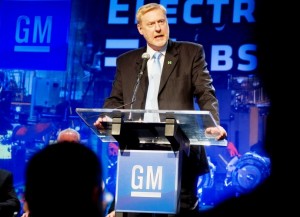General Motors Company today hosted a group of 200 members of the financial community and other stakeholders during a Global Business Conference at its Technical Center in Warren, Michigan.
The event was the first of its kind since the debut of the new company in July 2009 when it emerged from bankruptcy as a taxpayer-owned private firm and former ATT telephone executive Ed Whitacre took over as Chairman.
The conference had all the appearances of a hastily arrange public relations event that was likely constrained in content by an impending filing with the U.S. Securities and Exchange Commission to take the taxpayer held company public.
Once GM files, it will be subject to a “blackout period” on such events until its public offering is complete – a process that is largely outside of GM’s control. Such a filing could come as early as next month when second quarter earnings become available, which the best companies do within weeks of closing, if not sooner.
GM had revenue of $31.5 billion and operating income of $1.2 billion during the first quarter of 2010. GM’s net income attributable to common stockholders was $865 million, resulting in earnings per share on a diluted basis of $1.66. It was the first quarterly profit at the company since 2007, and a necessary prelude to an initial public offering or IPO.
The conference featured a review of GM’s global business, with updates by Chairman and CEO Ed Whitacre, Vice Chairman Steve Girsky, Vice Chairman and CFO, Chris Liddell, and GM’s regional presidents. Vice Chairman of Global Product Operations Tom Stephens provided a review of GM’s global product portfolio, and an early preview of some upcoming products, including the next versions of the Opel Insignia, Chevrolet Malibu, and Cadillac CTS.
Most of it was boilerplate and platitudes, which if bottled could prove to be a great benefit to insomniacs.
However, two things were notable for close followers of the company. One concerned finance, while the other dealt with product development – two areas that need to work together better than previously if GM is to survive the ongoing “take no prisoners car wars.”
Liddell, the CFO fresh from obscenely cash rich Microsoft, outlined where he thought GM’s balance sheet needed to go, and then admitted it would take some time to get there. Of particular concern are GM’s debt and unfunded pension liabilities, $26.8 billion and $15.4 billion respectively, which overwhelm its $30 billion in taxpayer supplied cash. Overall, GM owes more than $42 billion if you take into account all obligations.
Liddell candidly said that it would take a “few years to achieve” no debt and fully funded pension plan, which is where GM needs to be to earn a strong investment grade rating – his goal. “We lost our way during the past ten years,” Liddell said, admitting the obvious financial foolery and the mountains of debt, which led to insolvency.
Liddell’s vision appears to be one that returns GM to the halcyon days of the 1950s and 1960s, when it was producing a 10% net return, even though it was paying taxes of 50% on earnings. GM’s biggest problem then was what to do with the cash generated, and avoiding the wrath of regulators who thought it too big since it controlled more than half of the market, according to Joe Phillippi of the AutoTrends consultancy and a long time financial analyst.
The other notable development came from Tom Stephens, Vice Chairman of Global Product Operations, who, while not as flashy or boastful as the now retired Bob Lutz, his predecessor, is likely one of the most competent and underrated “car guys” in the business.
Stephens said that GM is abandoning the old major or new platform product-development cycle, which was followed by a minor freshening every couple of years over a six to eight year period. Stephens is pursuing, well, non-minor upgrades that the customer can see every couple of years so that GM can increase the price customers are willing to pay – while improving the vehicle.
This compares with the old approach where a new vehicle was introduced and then “decontented” to get the cost down to increase revenues as incentives increased on an aging product, until it was replaced – at great expense – with all new. Then the decontenting started anew.
It was and is a vicious cycle downward for companies pursuing it. The customer lost of course with this process, and ultimately so did GM, as its plummeting market share over decades proved.
“You don’t take out anything to make it the world’s best vehicle,” said Stephens on the new product development thinking.
This philosophy coupled with a radical (for GM but not Toyota and others) commonization of vehicle architectures offers great promise for competitive products and profits. For example, Stephens said just a couple of years ago GM had five different architectures for mid-size vehicles – yes five. Now it has one with 16 models derived from it.
“I keep my costs down,” said Stephens. “Every cost you can think of – material costs, engineering costs, investment costs – and so it’s gotta be good.”
It will be good if GM can consistently execute such a PD program, and execute executives who deviate from the process.
Stephens went on to point out that in emerging markets such as China – the world’s largest market now and perhaps forever — the demand for the latest technology is being pushed by regulations governing, say, CO2. Be being able to share existing technology, GM can meet new regulations faster and at less expense than competitors can. And as anyone who has dealt with the Chinese knows, they want the latest – now.

